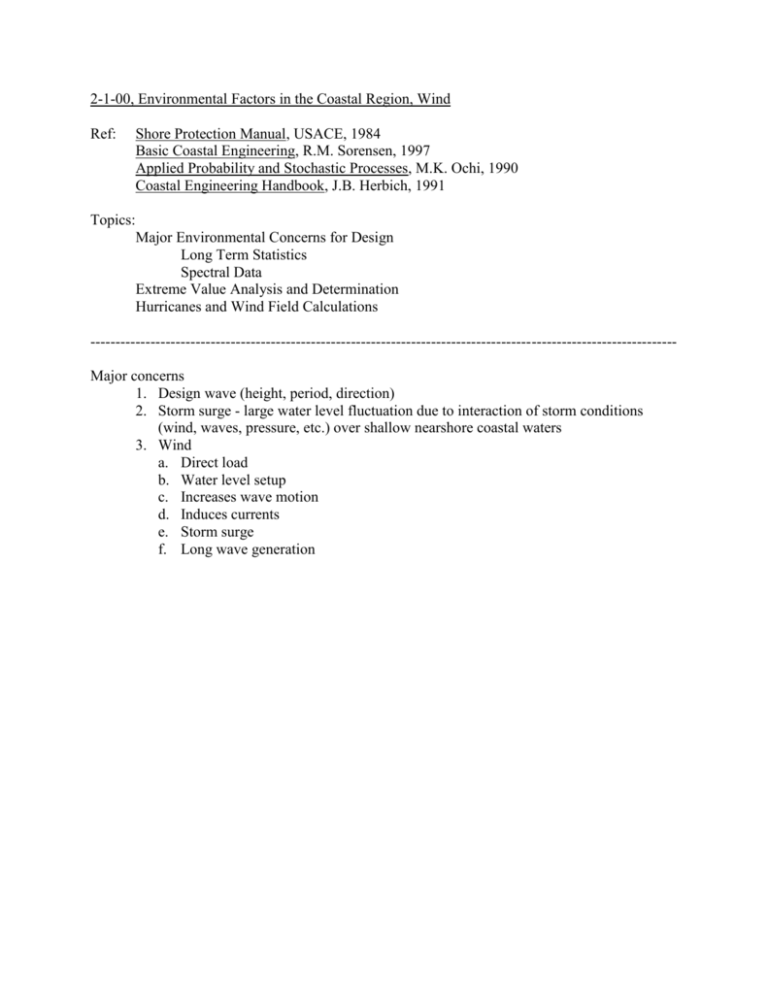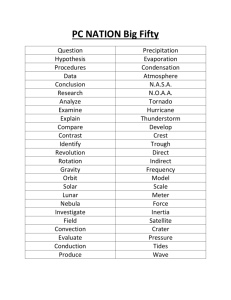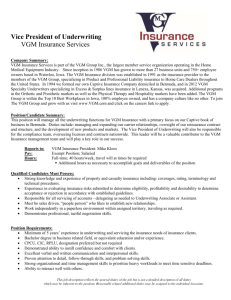Environmental Factors in the Coastal Region
advertisement

2-1-00, Environmental Factors in the Coastal Region, Wind
Ref:
Shore Protection Manual, USACE, 1984
Basic Coastal Engineering, R.M. Sorensen, 1997
Applied Probability and Stochastic Processes, M.K. Ochi, 1990
Coastal Engineering Handbook, J.B. Herbich, 1991
Topics:
Major Environmental Concerns for Design
Long Term Statistics
Spectral Data
Extreme Value Analysis and Determination
Hurricanes and Wind Field Calculations
--------------------------------------------------------------------------------------------------------------------Major concerns
1. Design wave (height, period, direction)
2. Storm surge - large water level fluctuation due to interaction of storm conditions
(wind, waves, pressure, etc.) over shallow nearshore coastal waters
3. Wind
a. Direct load
b. Water level setup
c. Increases wave motion
d. Induces currents
e. Storm surge
f. Long wave generation
Information Sources and uses:
Wave Information
•measured data
•hindcasting
•modeling
Analysis
•long term statistics
•storm waves
Distribution
•wave height
•wave period
•wave direction
•wave rose
Design Parameters
•significant wave height, H1/3, T1/3
•extreme wave height, He, Te
•modal period
Applications
•wave forces on structures
•wave run-up & overtopping
•rubble mound stability
Applications
•days of calmness
•operation days
•construction days/ schedule
•wave energy flux
Long Term Statistics
5-7 years of data required
seasonal variability
extreme wave (unless depth limited… see breaking waves)
H1/3 = 1.416HRMS ; H1/10 = 1.800HRMS
Spectral Data
Havg = H1/10
H
E(f)
Havg = H1/3
fm
66% 90%
F(H)
modal freq
f
Extreme Value Analysis/ Return Interval Determination - graphical method
**Requires large data set (> 30 events)
Based on the cumulative distribution function, F(xn), where
Pr{X xn} = 1 - F(xn) return interval T ( xn ) 1
1 F ( xn )
Case 1: Have ordered sample, y1 < y2 < … < yn
1. Plot ln(n) vs. ln(xn)
2. Extend plot to desired ln(N), e.g. N for 100 years
Note: N is a number of observations for a given time interval
i.e. m observations per year, let T = desired years (100) N = T x m
3. For desired N, find xN on plot
ln(N)
ln(n)
End of data set
ln(xN)
ln(xn)
Case 2: Have random data, X with N = total number of observations
1. Build histogram with data set, X
gives freq. (f) and center bin, y1 < y2 < … < yn
n
2. tabulate associated distribution function F ( xn )
fi
i 1
N
n
1
1 F xn
3. Plot ln(n) vs. ln(xn) and find yn for the desired T as above
Case 3: Limited data set (i.e. not sufficiently large observations)
Other methods require choosing a distribution function F(xn) based on the
data being examined. Various functions will be discussed later.
Hurricanes and Wind Fields
wind direction
is parallel to
direction of
advance
Maximum Wind Line
Hurricane (typhoon, cyclone) cyclonic storm having wind speeds in excess of 65 knots (120 kph, 75 mph)
driving mechanism is warm moist air, must have water temp > 22C to form
diameter generally < 300 nm (550 km, 345 mi)
dissipate at higher latitudes and over land due to deficiency of warm moist air
North Atlantic season June to November, most in August to October
US National Weather Service developed the Standard Project Hurricane (SPH) and the
Probable Maximum Hurricane (PMH) based on return interval analysis of
significant hurricane parameters
SPH has "a severe combination of values of meteorological parameters that will
give high sustained wind speeds reasonably characteristic of a specific
location." (return interval is several hundred years, usu. treated as 100 year
storm)
PMH has "a combination of values of meteorological parameters that will give
highest sustained wind speed that probably can occur at a specific
location." (design of coastal nuclear power plants)
Calculations (from SPM, Chapter 3)
Pressure field:
pr p e
e R / r , (1979 NOAA formula)
p a pe
pe = pressure at the eye (center), lowest pressure (as low as 26 inHg
recorded)
pr = pressure at radius r from eye (units of Pa or psf)
pa = ambient pressure at periphery (standard atmos. 29.92 inHg)
R = radius of maximum wind (usu. 10 - 30 nm from eye)
p
R
p a pe 2 e R / r
r
r
Gradient or Geostrophic wind (i.e. velocity along a streamline)
Pressure gradient becomes:
Vg2
r
fVg
1
pa pe R2 e R / r
a
r
Vg = gradient wind velocity
a = air density (kg/m3 or lbm/ft3)
f = 2sin Coriolis parameter, = earth rotation, = latitude
Complete solution
2
rf
1
R
rf
V g p a pe e R / r
2
r
2 a
or
2
Vgm
Rf
1
Rf
pa pe e 1
2
2 a
generally f and R are small values
Rf
1
pa pe e 1
2
a
for the Northern Hemisphere, maximum gradient wind speed corrected to
10 meter height (instrument level)
Vgm
Metric units:
Vgm 0.447 14.5 pa pe 2 0.31 fR
Vgm in m/s; pa, pe in mm Hg; f in rad/hr and R in km
English units:
1
Vgm 0.868 73 pa pe 2 0.575 fR
Vgm in knots; pa, pe in in Hg; f in rad/hr and R in
nautical miles
1
Given
1.
2.
3.
4.
central pressure (po, pe, or CPI, Central Pressure Index)
radius of maximum wind
peripheral (ambient) pressure (pn, pa) (1013 mb, 29.92 in Hg)
forward velocity (VF)
A 2D wind field can be constructed by substituting a variable distance from the
storm center (r) for the radius of maximum wind (R) in the Vgm equations, giving
Vg(r), or the gradient wind speed as a function of the radius.
Corrections for Maximum Sustained Wind and Storm Motion:
Maximum Sustained Wind Speed is defined as the maximum hourlyaveraged wind speed.
Stationary Storm
Maximum sustained wind speed" (VR) at instrument height and radius R
VR 0.865V gm
Moving Storm and Wind Field
For a moving storm the wind field becomes skewed and the actual wind
speed is the vector sum of the rotational component (Vg) and the forward
speed (VF). For a counterclockwise wind field (cyclonic wind in the
Northern Hemisphere) the wind field is stronger on the right side than on
the left (see hurricane diagram).
The actual angle where the maximum wind occurs is 15 to 165 degrees
from the forward velocity line. This is due to the fact that the wind is not
directed exactly tangential to the radius, but slightly inward, toward the
eye. Therefore, the wind and the direction of motion are parallel at a point
different from 90 degrees from the direction of motion. (see hurricane
diagram). Maximum velocity wind line is customarily set at 115 degrees.
Maximum sustained wind speed at instrument height is
VR 0.865Vgm 0.5VF
Wind velocity at radius R is
V r , 0.865Vg r 0.5VF cos
where is measured from the maximum velocity line.
Additional Corrections and Considerations
Elevation - frictional force as altitude approaches sea level (wind
magnitude decreases and direction spirals, Ekman Spiral)
Logarithmic law:
Uz 1 z
ln ,
U k z o
U
o
Ekman Spiral applied to Wind Above the Sea Surface
Decreasing
Magnitude of
Wind Speed
Water's surface
Duration - wind is unsteady shorter averaging time gives higher peak
speed, differences in peak speed for various averaging times indicate
"gustiness"
Offshore work - international convention to use 10 minute
averaging time.
Structural design - use time corresponding to minimum structure
response time (seconds)
Apply "duration conversion" factor to convert
U 10 min 0.056 ln t 0.64 U t
Turbulence & Gustiness - requires spectral representation of wind speed







